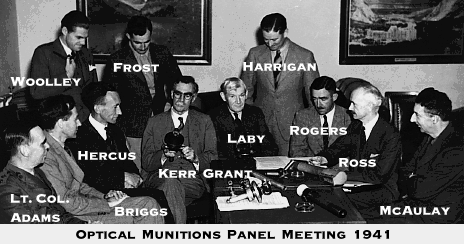




Australia's munitions production problems in the early days of the war were in many ways much more difficult than those of any other Commonwealth country. For the first time in our history, we were thrown completely on our own resources. Almost overnight our lines of supply from Britain dried up, and yet we had to equip our own Army, Navy and Air Force and keep our essential civil production going. We were out on a limb, geographically and every other way - and no one could climb out to help us.(1)
The Optical Munitions Panel was formed in June 1940. Between July and December 1940 it met six times. It then met every two months until it was disbanded in November 1945. The Panel held a total of thirty-two meetings. The Chair of the Panel was T.H. Laby. He resigned in 1944 due to ill-health and Kerr Grant undertook the position of Chair until the Panel's end. The Secretary of the Panel was J.S. Rogers, who also wrote its official history.
Three Government Laboratories were involved in the work of the Panel:
Australian armed services and industrial firms were also represented.
The Optical Munitions Panel name was changed to the Scientific Instruments and Optical Panel near the end of the Second World War in an unsuccessful attempt to widen and continue the Panel's work after the war.
Professor T.H. Laby (Chair) (University of Melbourne)
Lt-Col G.H. Adams (Assistant Director of Artillery AHQ)
F.S. Daley (Department of Defence, Ordnance Department, Maribyrnong)
N.A. Esserman (National Standards Laboratory)
Professor Kerr Grant (University of Adelaide)
L.J. Hartnett (Department of Munitions)
Associate Professer E.O. Hercus (University of Melbourne)
E.L. Sayce (Munitions Supply Laboratories)
Professor O.U. Vonwiller (University of Sydney)
Dr R. v.d.R. Woolley (Commonwealth Solar Observatory)
J.S. Rogers (Secretary) (University of Melbourne)

Early on, the Panel decided against a centralised research institution, preferring to give each senior physicist several optical instruments to design. Thus research was undertaken in the physicist's own laboratory, wherever it was located in Australia. The instruments designed by the physicists would then be manufactured by local industrial firms, although often in frustratingly small numbers. The task of actually producing the first optical glass in Australia was given to Hartung, who worked successfully in conjunction with Australian Consolidated Industries.
The Panel mostly met at the University of Melbourne, where Laby was based. Occasionally it met at other locations where optical munitions work was being undertaken, such as the Hobart Annexe, and the Commonwealth Solar Observatory in Canberra.
The Panel was also a unique opportunity for Australian physicists to meet together regularly and to work on a common cause. The Australian Branch of the Institute of Physics was only a relatively new organisation, having been established only fifteen years previously. Its members were separated by great distances; thus, the work o the Panel afforded the scientists a chance to strengthen their personal and professional ties while doing important war-time work.
Kerr Grant chaired the final meeting of the Optical Munitions Panel in November 1945. At this time, the Panel made a formal resolution stating that: 'The success of the work of the Panel has been due in no small manner to the zeal and unsparing efforts of Dr. Laby'. Kerr Grant also said:
Australia was highly indebted to [Laby] for the zeal with which he had devoted himself to the work of the Panel in its early years. Dr Laby had never spared himself and it was his overwork which had led to his breakdown in health which had necessitated his resignation.(2)
The Panel also talked a lot about the future direction of optics in Australia. They felt there were two possibilities: optical instruments could still be made for the armed services and Government departments; and/or optical instruments like microscopes, binoculars and telescopes could be made for schools and universities and the general public. Despite the Panel's attempts to continue this industry after the war, nearly the entire optics industry was closed down at the end of the war.
It is not surprising that the optics industry did not continue in Australia. Chance Brothers and other overseas optics firms were not encouraging the Australians to continue. The Australian Government did not support any further work in this field - it felt there was not enough demand for an optics industry in the domestic market - and did not consider export opportunities.
The glass furnaces were shut down in Sydney in 1945 and the Hobart Annexe was sold to Waterworth. Some scientists involved in the Panel's wartime work did remain in the optics field, although most wished to return to their own areas of research; but some optical research continued in universities, the CSIR/O and the Munitions Supply Laboratories.
(1) Sir Laurence Hartnett (1973), Big Wheels and Little Wheels, 2nd edn, Gold Star Publications, Hawthorn, Victoria, p. 133.
(2) H.C. Bolton (1990), 'Optical Instruments in Australia in the 1939-45 War: successes and lost opportunities', Australian Physicist, vol. 27, no. 3, March, pp. 37.








 Top |
Bright SPARCS |
ASAPWeb
Top |
Bright SPARCS |
ASAPWeb
